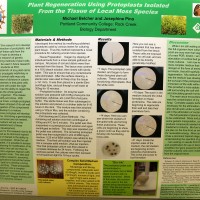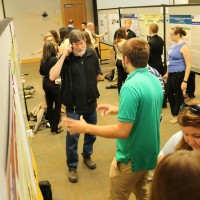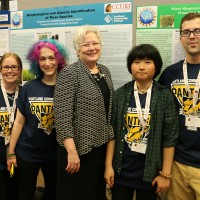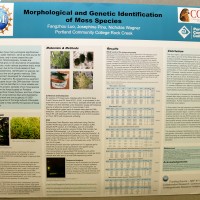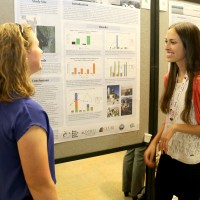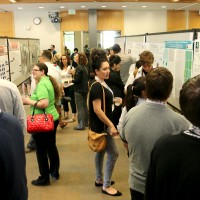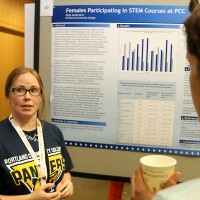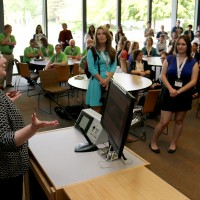This content was published: June 29, 2015. Phone numbers, email addresses, and other information may have changed.
Posterized: CCURI poster session features cool PCC research
Photos and story by James Hill
It was like PCC had its own research and development department.
In May, five PCC students – Michael Belcher, Fangzhou Luo, Nicholas Wagner, Sara Citrenbaum and Paige Gyldersleve – presented their science research results at the annual Community College Undergraduate Research Initiative Regional Spring Poster Session at the Rock Creek Campus. Their work included plant regeneration, the genetic identification of moss, the hygienic safety of high speed hand dryers, and how females participate in STEM-related courses at PCC.
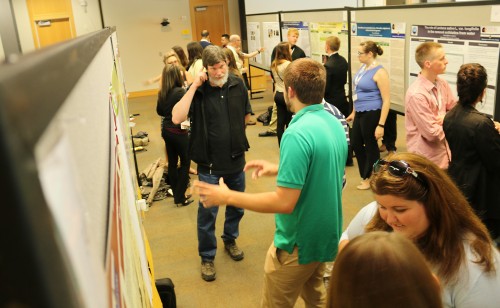
Attendees, which included staff and faculty from PCC and elsewhere, got a chance to view poster summaries of the research projects and chat with the students about their findings.
They presented their work along with more than 75 other students representing more than 50 community colleges from around the country. Attendees, which included staff and faculty from PCC and elsewhere, got a chance to view poster summaries of the research projects and chat with the students about their findings.
“The overarching goal is to teach science better so that students are actually doing science,” said Josephine Pino, biology instructor. “The CCURI network emphasizes people working together, communicating and learning from each other’s mistakes and successes; the posters are part of that. They are independent projects and the research is at a pretty high level.”
The National Science Foundation-funded CCURI project involves 26 partner institutions and has used Rock Creek as the site for its poster sessions for the past few years. It uses an inquiry-based teaching model where students are exposed to real-world science through a case study in an introductory course followed by hands-on research. CCURI provides institutions with introductory workshops and conferences that build regional and national collaborations, create start-up supplies, and provides faculty with development opportunities.
“I know that every single one of you are going to be a success as you pursue your dreams and research,” Rock Creek President Sandra Fowler-Hill told the students before the session began. “I hope to see that work continue and that this is only the beginning.”
Projects tackle hand dryers, STEM participation, DNA sequencing
The research covered an interesting spectrum of issues. Gyldersleve used statistical analysis of data provided by the Office of Institutional Effectiveness to gauge the participation of women in STEM-related classes at the college. Her hypothesis was that certain fields like computer science and engineering had lower participation rates while chemistry and biology would have higher ones. She reported in her conclusion that these notions were proven correct by the data.
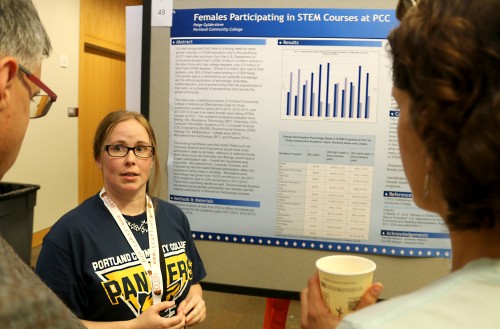
Paige Gyldersleve used statistical analysis of data provided by the Office of Institutional Effectiveness to gauge the participation of women in STEM-related classes at the college.
Citrenbaum examined the use of high speed hand dryers in lieu of paper towels at PCC and analyzed how splash back might contain bacteria and be transferred to the user. She concluded they do have bacteria, but it’s unclear if it’s transferred to the user with any significance.
Luo and Wagner’s research dovetailed into Belcher’s plant-cell project. They took samples of six moss species collected from the Rock Creek Campus forest and identified four of them using botanical keys and illustrations. They used DNA sequencing to identify the other two species in the samples. They concluded that using traditional taxonomy needs genetic barcoding as a supplementing tool.
Student creating bio-printing roadmap
For Belcher, his goal was to develop a procedure for the extraction of protoplasts (cells with their walls removed) and subsequent culturing of these cells from the tissue of moss from the Rock Creek forest. He is now developing a procedure to aid in the research of genetic modification and culturing methods of plant cells. Belcher, who presented his work to Congresswoman Suzanne Bonamici during spring term, is working with the Sylvania Campus MakerSpace to make a bioprinter that would use bio-ink created by the extraction to grow modified cells. He said these methods could be used in future research by instructors and students at PCC.
“I’m hoping to be able to go out into the forest, take a leaf off a tree, do these series of washes and enzyme cycles, and then be able to isolate cells from that tissue and then modify their genetics,” Belcher said at the poster session. “And then propagate, re-grow and clone these organisms. I have created a solution that can be printed in their bioprinter and it is just basically isolating the few nuances of regrowing it. Hopefully, I’m just a few weeks away from being able to print this and then have them propagate. It’s almost as if the proof of concept is living art.
“It’s a new way to do something and people are striving to accomplish it,” he added. “If they are able to do that then there is no limit to the proteins you can have it produce.”
Belcher, who is transferring this fall to Oregon State University’s Food Science & Technology Program, spent three months researching the project and studying plant physiology. Eventually, he hopes to work in genetics, but for now he’s just trying to perfect his bioprinting platform for the future generation of students to use in the Bioscience Technology Program.
“In recent years we’ve come to think of science as a collection of facts,” Pino said. “This whole initiative is trying to turn that on its head and say ‘no, science is a process.’ You use facts and you learn facts along the way, but science is about asking questions and designing ways to find the answers. It’s very transformative. The goal is to bring this to more and more students.”

